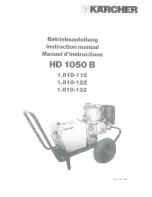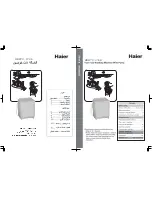
4
•
Follow the guidelines below for preparing the wash load.
•
Read the
Operating Instructions
for operating your specific model.
•
Always read and follow fabric care and laundry product labels.
To reduce the risk of fire, electrical shock, or injury to persons, read
Important Safety Instructions
before operating this washer.
1. Sort laundry into loads that can be washed together.
Sort items by recommended water temperatures and wash time.
•
Separate white, light, and colorfast items from dark and noncolorfast items.
•
Separate items which shed lint from items which attract lint. Permanent
press, synthetic, knit and corduroy items will pick up lint from towels, rugs
and chenille bedspreads.
•
Separate heavily soiled items from lightly soiled items.
•
Separate lacy, sheer and loosely knit items from sturdy items.
•
Do not machine wash items containing fiberglass. Small particles of
fiberglass left in the drum may stick to fabrics in other loads and cause skin
irritation.
2. Prepare items for washing.
•
Empty pockets.
•
Brush off lint and dirt. Shake out rugs and beach towels.
•
Close zippers, fasten hooks, tie strings and sashes, and remove nonwashable
trims and ornaments.
•
Remove pins, decorative buttons, belt buckles, and other objects which could
be damaged. This also helps protect other items in the wash load.
•
Mend rips and tears to prevent further damage during washing.
•
Place delicate items such as bras, shoulder pads, hosiery, and belts in a mesh
bag to prevent tangling during the wash cycle.
•
Turn knit items inside out to prevent pilling.
3. Pretreat stains and heavy soil.
See
Stain Removal
for details.
4.
Add laundry load to washer.
•
Combine large and small items in a load. Load large items first. Large items
should not be more than half the total wash load.
•
Washing single items such as a sweater, towel or jeans may cause an out-of-
balance load. Add 1 or 2 similar items to help balance the load.
•
Single heavy items such as a bedspread can be washed separately.
•
The washer can be fully loaded, but the items should not be tightly packed.
The door should close easily.
Sort laundry into loads that can be washed
together.
Empty pockets.
Place delicate items in a mesh bag.
Add laundry load to washer.
Washing Procedures
• To prevent serious personal injury and damage to the washer:
-
All repairs and servicing must be performed by an authorized servicer
unless specifically recommended in this
Owner's Guide. Use only authorized factory parts.
-
Do not
tamper with controls.
-
Do not
install or store the washer where it will be exposed to the weather.
-
Do not
install on carpet. Install washer on a solid floor. It may be necessary to reinforce the floor to prevent vibration or
movement.
•
To reduce the risk of electric shock, disconnect this appliance from the power supply before attempting any user
maintenance. Turning the controls to the OFF position does not disconnect this appliance from the power supply.
• To prevent injury, do not reach into the washer while parts are moving. Before loading, unloading or adding items, push in
the cycle selector knob and allow the drum to coast to a complete stop before reaching inside.
• Failure to comply with these warnings could result in serious personal injuries.
• This washer is equipped with an electrical overload protector. The motor will stop if it becomes overheated. The washer
will automatically restart after a cool down period of up to 30 minutes, if the washer has not been manually turned off
during this time.
Important Safety Instructions
(continued)





























